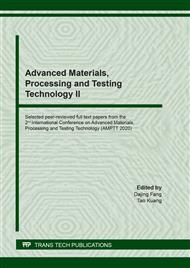[1]
Chepil, W. S. Dynamics of wind erosion: I. Nature of movement of soil by wind. Soil Science. 1945, 60, 305–320.
DOI: 10.1097/00010694-194510000-00004
Google Scholar
[2]
Nordstrom, K. F., & Hotta, S. Wind erosion from cropland in the USA: a review of problems, solutions and prospects.Geoderma. 2004, 121, 157–167.
DOI: 10.1016/j.geoderma.2003.11.012
Google Scholar
[3]
De Vos, J.A. Testing composite as an anti-wind erosion agent in a wind tunnel. Soil Technology. 1996, 9, 209-221.
DOI: 10.1016/s0933-3630(96)00017-7
Google Scholar
[4]
Yang, J., Wang, F., Fang, L., Tan, T.W. Synthesis, characterization and application of a novel chemical sand fixing agent-poly (aspartic acid) and its composites. Environmental Pollution. 2007, 149 (1), 125-130.
DOI: 10.1016/j.envpol.2006.12.021
Google Scholar
[5]
Barth RC, Klemmedson JO. Amount and distribution of dry matter, nitrogen, and organic carbon in soil–plant systems of mesquite and palo verde. J Range Manage. 1982, 35, 412–418.
DOI: 10.2307/3898594
Google Scholar
[6]
Garner W, Steinberger Y. A proposed mechanism for the formation of fertile islands, in the desert ecosystem. J Arid Environ. 1989, 16, 257–262.
DOI: 10.1016/s0140-1963(18)30941-8
Google Scholar
[7]
Hook PB, Burke IC, Lauenroth WK. Heterogeneity of soil and plant N and C associated with individual plants and openings in North-American shortgrass steppe. Plant Soil. 1991, 138, 247–256.
DOI: 10.1007/bf00012252
Google Scholar
[8]
Burke IC, Lauenroth WK, Coffin DP. Soil organic-matter recovery in semiarid grasslands: implications for the conservation reserve program. Ecol Appl. 1995, 5, 793–801.
DOI: 10.2307/1941987
Google Scholar
[9]
Li Y, Cui J, Zhang T, Okuro T, Drake S. Effectiveness of sandfixing measures on desert land restoration in Kerqin Sandy Land, northern China. Ecol Eng. 2009, 35, 118–127.
DOI: 10.1016/j.ecoleng.2008.09.013
Google Scholar
[10]
Shawqui M. Lahalih. Development and Evaluation of New Multipurpose Soil Additives. Ind. Eng. Chem. Res. 1998. 37, 420-426.
DOI: 10.1021/ie970493p
Google Scholar
[11]
Z. Dong, L. Wang, S.Zhao. A potential compound for sand fixation synthesized from the effluent of pulp and paper mills. Journal of Arid Environments. 2008, 72, 1388-1393.
DOI: 10.1016/j.jaridenv.2008.02.008
Google Scholar
[12]
S. M. Lahalih, E. F. Ghloum. Rheological properties of new polymer compositions for sand consolidation and water shutoff in oil wells. Journal of Applied Polymer Science. 2006, 104, 2076-2087.
DOI: 10.1002/app.25261
Google Scholar
[13]
Jun Yang, Fang Wang, Li Fang, Tianwei Tan. The effects of aging tests on a novel chemical sand-fixing agent polyaspartic acid. Composites Science and Technology. 2007, 67, 2160-2164.
DOI: 10.1016/j.compscitech.2006.10.025
Google Scholar
[14]
Xiao Yan Li, Lian You Liu, Jian Hua Wang. Wind tunnel simulation of aeolian sandy soil erodibility under human disturbance. Geomorphology. 2004, 59, 3-11.
DOI: 10.1016/j.geomorph.2003.09.001
Google Scholar
[15]
Kai Yang, Zejun Tang. Effectiveness of fly ash and polyacrylamide as a sand-fixing Agent for wind erosion control. Water Air Soil Pollut. 2012, 223, 4065-4074.
DOI: 10.1007/s11270-012-1173-x
Google Scholar
[16]
Jun Yang, Hui Cao, Fang Wang, Tianwei Tan. Application and appreciation of chemical sand fixing agent poly (aspartic acid) and its composites. Environmental Pollution. 2007, 150, 381-384.
DOI: 10.1016/j.envpol.2007.05.009
Google Scholar
[17]
Jin Liu, Bin Shi, Yi Lu, et al. Effectiveness of a new organic polymer sand-fixing agent on sand fixation. Environ Earth Sci. 2012, 65, 589-595.
DOI: 10.1007/s12665-011-1106-9
Google Scholar
[18]
Marina Alekhina, Olga Ershova, Andreas Ebert, et al. Softwood kraft lignin for value-added applications: Fractionation and structural characterization. Industrial Crops and Products. 2015, 66, 220-228.
DOI: 10.1016/j.indcrop.2014.12.021
Google Scholar
[19]
Miao Wua, Donghong Zhao, Jinhui Pang, et al. Separation and characterization of lignin obtained by catalytic hydrothermal pretreatment of cotton stalk. Industrial Crops and Products. 2015, 66, 123-130.
DOI: 10.1016/j.indcrop.2014.12.056
Google Scholar
[20]
Dereca Watkins, Md. Nuruddin, Mahesh Hosur, et al. Extraction and characterization of lignin from different biomass resources. J mater res technol. 2015, 4, 26-32.
Google Scholar
[21]
Élé onore J. Kibrik,,Oliver Steinhof,Günter Scherr,, et al. On-Line NMR Spectroscopic Reaction Kinetic Study of Urea−Formaldehyde Resin Synthesis. Ind. Eng. Chem. Res. 2014, 53, 12602-12613.
DOI: 10.1021/ie5001746
Google Scholar


